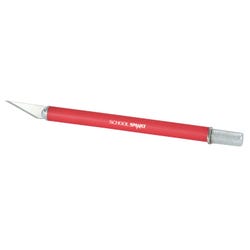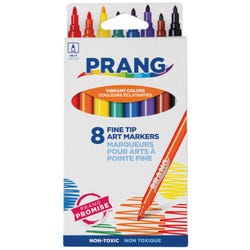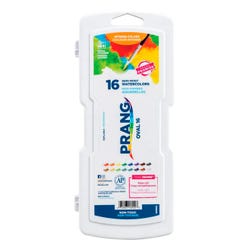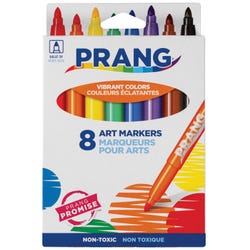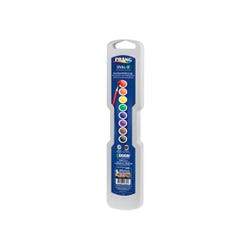Puzzling Emotions

Description
Lesson Plan and Artwork by Sue Loesl
The Puzzling Emotions lesson plan is designed to facilitate Social and Emotional Learning (SEL). It encourages students to develop empathy, compassion, and understanding not only by looking within themselves, but also by exploring with others. Through the creation of a group puzzle, students will have a shared experience of the various ways that others can envision similar emotions through colors, lines, and shapes.
Objectives
- Explore creating imagery that reflects various emotions through colors, lines and shapes.
- Design a piece of art that reflects an emotion using markers and watercolors on foam board.
- Engage in discussions with other students about illustrating emotions.
- Create a group art puzzle that is inspired by imagery of emotions.
Supplies Needed
Prang® Semi-Moist Watercolor Paints, Plastic Oval Pan, 8 Assorted Colors
Prang® Non-Toxic Semi-Moist Wax-Free Watercolor Paints, Plastic Oval Pan, 16 Assorted Colors
Prang® Washable Semi-Moist Watercolor Paint Set, 8 Assorted Metallic Color
Prang® Washable Semi-Moist Watercolor Paint Set, 8 Assorted Glitter Colors
Prang® Classic Art Markers, Bullet Tip, Assorted Colors, Set of 8
Prang® Classic Art Markers, Fine Line, Assorted Colors, Set of 8
School Smart® B Artist Knife Blade, No 11, Comfortable Grip
School Smart® Foam Boards, 20 x 30 Inches, White, Pack of 10
Sax® Synthetic Watercolor Brushes, Size 6, Pack of 3
Sax® Sulphite Drawing Paper, 60 lb, 9 x 12 Inches, Extra-White, Pack of 500
Standards
Standard #1: Generate and conceptualize artistic ideas and work.
Standard #6: Convey meaning through the presentation of artistic work.
Standard #10: Synthesize and relate knowledge and personal experiences to make art.
Instructions
1
Precut 20”x 30” School Smart Foam Board with School Smart Comfort Grip Knife into random pieces depending upon number of students in class. Sample has 11 puzzle pieces of similar sized, yet differently shaped pieces. The 20” x 30” board could be cut into smaller pieces for multiple mini puzzles. Cut it into 10”x 15” to create four puzzles and then cut each into 5 puzzle shape pieces for each puzzle. Each student receives one piece of puzzle to design.
2
A sharp knife blade works best to cut the foam board. A surface such as a rubber mat placed underneath the foam board will allow the knife to cut cleanly through. Indicate on the back of the puzzle pieces a number or letter so students know which puzzle their piece belongs to, which side is up and how the piece is oriented within the puzzle.
3
Present a large variety of emotion words such as sad, mad, scared, peaceful, happy, confused, surprised, etc. as a handout or written large on a whiteboard or Smartboard. Discuss with students the emotion words, inquiring as to what kinds of colors, lines and shapes might be evoked by these words. Tell students that everyone does not consider these emotion words in the same way, that individual experiences create personal reflections of the words.
4
Describe to the students that they will be designing one piece of a group puzzle using the mediums of watercolors and markers. Show the students the white foam board precut puzzles assembled to create the sense of a group project.
5
Students each design one puzzle piece with one emotion. Students can randomly choose a folded paper with an emotion; all different. Or students are given a list of emotions to choose from, with possibly more than one student choosing the same emotion to illustrate. Additionally, the entire puzzle can be comprised of just one emotion.
6
Remind students how the puzzle pieces are aligned within the puzzle(s), informing them that there is a letter or number on the back that indicates the back of their puzzle piece, and to which puzzle their piece belongs. Randomly hand out pieces of the puzzle or have students choose.
7
Determine if students are going to write the emotion on the front or the back of the puzzle piece. If on back, there is an air of mystery as to which emotion is being illustrated, inspiring group discussions when the puzzle is put together again. Optionally, write the emotion on the front in a font depicting the emotion and direct students to design around the written word. Either technique can be effective but choosing one for the entire puzzle is preferable.
8
Instruct students to use Prang Washable/Regular Watercolors, Prang Glitter/Metallic Watercolors, as well as Prang Classic Bullet Markers and Prang Fine Tip Art Markers to design their puzzle pieces. Students will also need watercolor brushes in various sizes and water containers. The foam board finish isn’t as absorbent as other papers but supports some interesting effects when used with watercolors and markers. Using less water enhances darker pigment. Review watercolor techniques if needed.
9
Direct students to think about their emotion and consider which colors, lines and shapes can be used to illustrate the emotion. Encourage students to begin using the media directly on the puzzle pieces without pre-sketching. Some students may prefer to sketch their designs before putting the media onto the puzzle piece, and this is acceptable. The students can then transfer their designs to the puzzle piece and continue design work.
10
Let the puzzle pieces fully dry before putting the puzzle(s) back together.
11
The puzzle piece numbers or letters on the back can be called out in order, brought to the developing puzzle, and discussed while being laid into the puzzle. The students will find it interesting to see what other emotions their puzzle pieces evoke and how quickly their emotion is guessed, especially if the emotion words are not written on the front.
12
Encourage students to share their work and describe how they used colors, lines and shapes to illustrate their emotions. Point out to students the similarities and differences in the designs, especially when the puzzles have similar emotion words to illustrate.
13
Reassembled puzzles can be photographed for group effect, and then individual pieces can be returned to the students. Or, the finished puzzles can be mounted onto sturdy cardboard or matt board and displayed.




